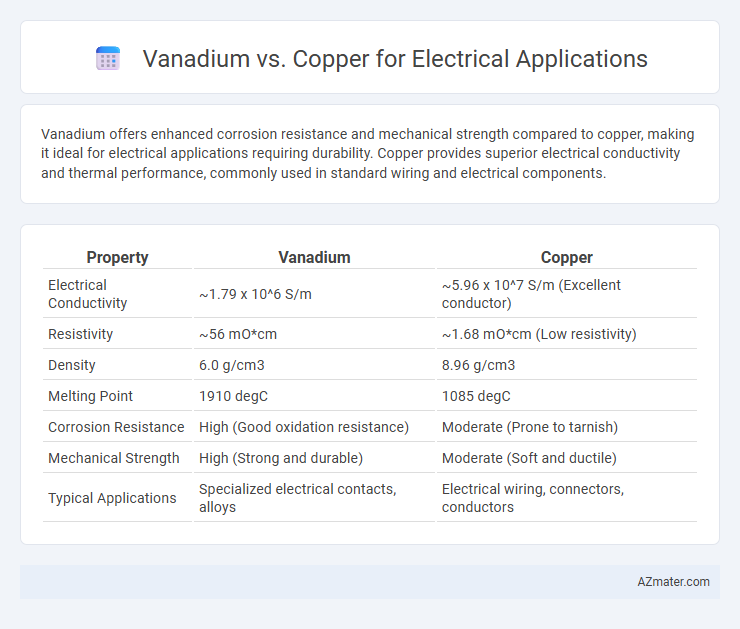Vanadium offers enhanced corrosion resistance and mechanical strength compared to copper, making it ideal for electrical applications requiring durability. Copper provides superior electrical conductivity and thermal performance, commonly used in standard wiring and electrical components.
Table of Comparison
| Property | Vanadium | Copper |
|---|---|---|
| Electrical Conductivity | ~1.79 x 10^6 S/m | ~5.96 x 10^7 S/m (Excellent conductor) |
| Resistivity | ~56 mO*cm | ~1.68 mO*cm (Low resistivity) |
| Density | 6.0 g/cm3 | 8.96 g/cm3 |
| Melting Point | 1910 degC | 1085 degC |
| Corrosion Resistance | High (Good oxidation resistance) | Moderate (Prone to tarnish) |
| Mechanical Strength | High (Strong and durable) | Moderate (Soft and ductile) |
| Typical Applications | Specialized electrical contacts, alloys | Electrical wiring, connectors, conductors |
Introduction to Vanadium and Copper in Electrical Applications
Vanadium and copper play distinct roles in electrical applications due to their unique properties. Copper is widely used for electrical wiring and conductors because of its excellent electrical conductivity and ductility. Vanadium, while less conductive, is primarily utilized as an alloying element to enhance the strength, corrosion resistance, and thermal stability of metals in specialized electrical components.
Electrical Conductivity: Vanadium vs Copper
Copper exhibits significantly higher electrical conductivity than vanadium, measuring approximately 5.96 x 10^7 S/m compared to vanadium's much lower value around 1.79 x 10^6 S/m. This makes copper the preferred choice for most electrical applications requiring efficient current flow and minimal energy loss. Vanadium's electrical conductivity is insufficient for conventional wiring but may be utilized in specialized alloy compositions to enhance mechanical properties rather than conductivity.
Thermal Conductivity Comparison
Vanadium exhibits significantly lower thermal conductivity compared to copper, making copper far superior for electrical applications requiring efficient heat dissipation. Copper's thermal conductivity ranges around 400 W/m*K, while vanadium's is approximately 30 W/m*K, limiting vanadium's effectiveness in managing thermal loads in electrical components. This fundamental difference makes copper the preferred choice for wiring and connectors where minimizing heat buildup is critical for performance and durability.
Mechanical Strength and Durability
Vanadium enhances copper alloys by significantly increasing mechanical strength and wear resistance, making them ideal for electrical applications requiring durability under mechanical stress. Copper, known for exceptional electrical conductivity, lacks the mechanical robustness of vanadium-infused alloys, which resist deformation and maintain conductivity over extended cycles. Vanadium-copper composites provide a balanced solution combining high electrical performance with superior mechanical strength and prolonged operational lifespan.
Corrosion Resistance in Electrical Environments
Vanadium exhibits superior corrosion resistance compared to copper in electrical environments, making it ideal for applications exposed to harsh or oxidizing conditions. Copper, while highly conductive, tends to form surface oxides and sulfides that can degrade electrical performance over time. Vanadium's protective oxide layer enhances durability and maintains stable electrical conductivity, crucial for long-term reliability in corrosive settings.
Cost and Availability
Vanadium offers superior corrosion resistance and mechanical strength but is significantly more expensive and less abundant than copper, limiting its widespread use in electrical applications. Copper remains the preferred choice due to its excellent electrical conductivity, lower cost, and widespread availability worldwide. Cost-efficiency and supply stability make copper the dominant material for most electrical wiring and components despite vanadium's advantageous properties.
Weight and Density Considerations
Vanadium's density is approximately 6.11 g/cm3, significantly lower than copper's density of 8.96 g/cm3, making vanadium a lighter alternative for electrical applications where weight reduction is critical. Despite copper's superior electrical conductivity, vanadium's lower density can improve the strength-to-weight ratio in structural components within electrical systems. Engineers often balance copper's conductivity advantage against vanadium's lighter mass to optimize performance in aerospace and lightweight electrical designs.
Sustainability and Environmental Impact
Vanadium offers superior corrosion resistance and longer lifespan compared to copper, reducing the need for frequent replacements and minimizing environmental waste in electrical applications. Copper extraction is energy-intensive and associated with significant environmental pollution, whereas vanadium can often be sourced as a byproduct of steel production, promoting resource efficiency. The recyclability of both metals enhances sustainability, but vanadium's integration in energy storage systems further supports green technology development.
Application Suitability and Use Cases
Vanadium alloys offer exceptional strength and corrosion resistance, making them suitable for high-performance electrical connectors and components in aerospace and military applications where durability is critical. Copper, with its superior electrical conductivity and thermal performance, remains the preferred choice for wiring, electrical circuits, and power transmission systems in residential, commercial, and industrial settings. Selecting vanadium or copper depends on specific use cases requiring either enhanced mechanical properties or maximum electrical efficiency.
Future Trends in Electrical Materials
Vanadium is emerging as a promising material in electrical applications due to its superior strength, corrosion resistance, and ability to enhance alloy performance compared to traditional copper. Future trends indicate increased incorporation of vanadium in high-performance conductors and electric vehicle components, driven by the demand for lightweight and durable materials in energy storage and transmission systems. Innovations in vanadium-based nanomaterials and composites are expected to complement or even replace copper, optimizing electrical conductivity while improving mechanical properties and sustainability.

Infographic: Vanadium vs Copper for Electrical Application
 azmater.com
azmater.com